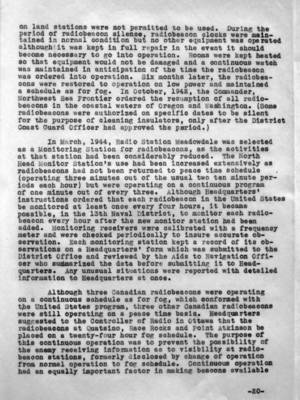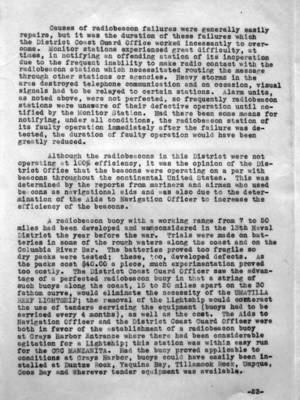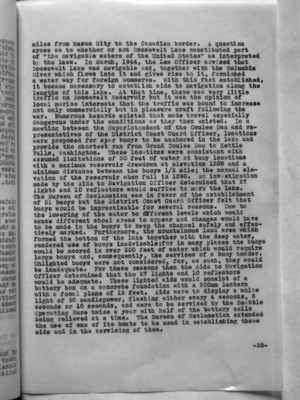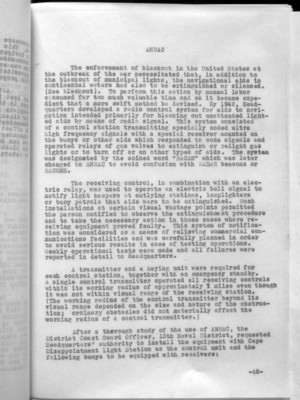Pages That Mention United States
Coast Guard District narrative histories 1945
39
on land stations were not permitted to be used. During the period of radiobeacon silence, radiobeacon clocks were maintained in normal condition but no other equipment was operated although it was kept in in full repair in the event it should become necessary to go into operation. Rooms were kept heated so that equipment would not be damaged and a continuous watch was maintained in anticipation of the time the radiobeacon was ordered into operation. Six months later, the radiobeacons were restored to operation on low power and maintained a schedule as for fog. In October, 1942, the Commander, Northwest Sea Frontier ordered the resumption of all radiobeacons in the coastal waters of Oregon and Washington. (Some radiobeacons were authorized on specific dates to be silent for the purpose of cleaning insulators, only after the District Coast Guard Officer had approved the period.)
In March, 1944, Radio Station Meadowdale was selected as a Monitoring Station for radiobeacons, as the activities at that station had been considerably reduced. The North Head Monitor Station's use had been increased extensively as radiobeacons had not been returned to peace time schedule (operating three minutes out of the usual two ten minute periods each hour) but were operating on a continuous program of one minute out of every three. Although Headquarters' instructions ordered that each radiobeacon in the United States be monitored at least once every four hours, it became possible, in the 13th Navel District, to monitor each radiobeacon every hour after the new monitor station had been added. Monitoring receivers were calibrated with a frequency meter and were checked periodically to insure accurate observation. Each monitoring station kept a record of its observations on a Headquarters' form which was submitted to the District Office and reviewed by the Aids to Navigation Officer who summarized the data before submitting it to Headquarters. Any unusual situations were reproted with detailed information to Headquarters at once.
Although three Canadian radiobeacons were operating on a continuous schedule as for fog, which conformed with the United States program, three other Canadian radiobeacons were still operating on a peace time basis. Headquarters suggested to the Controller of Radio in Ottawa that the radiobeacons at Quatsino, Race Rocks and Point Atkinson be placed on a twenty-four hour fog schedule. the purpose of this continuous operation was to prevent the possibility of the enemy receiving information as to visibility at radiobeacon stations, formerly disclosed by change of operation from normal operation to fog schedule. Continuous operation had an equally important factor in making beacons available
-20-
42
Causes of radiobeacon failures were generally easily repairs, but it was the duration of these failures which the District Coast Guard Office worked incessantly to overcome. Monitor stations experienced great difficulty, at times, in notifying an offending station of its inoperation due to the frequent inability to make radio contact with the radiobeacon station which necessitated routing the message through other stations or agencies. Heavy storms in the area destroyed telephone communication and on occasion, visual signals had to be relayed to certain stations. Alarm units, as noted above, were not perfected, so frequently radiobeacon stations were unaware of their defective operation until notified by the Monitor Station. Had there been some means for notifying, under all conditions, the radiobeacon station of its faulty operation immediately after the failure was detected, the duration of faulty operation would have been greatly reduced.
Although the radiobeacons in this District were not operating at 100% efficiency, it was the opinion of the District Office that the beacons were operating on a par with beacons throughout the continental United States. This was determined by the reports from mariners and airmen who used beacons as navigational aids and was also due to the determination of the Aids to Navigation Officer to increase the efficiency of the beacons.
A radiobeacon buoy with a working range from 7 to 50 miles had been developed and was considered in the 13th Naval District the year before the war. Trials were made on batteries in some of the rough waters along the coast and on the Columbia River Bar. The batteries proved too fragile so dry packs were tested; these, too, developed defects. As the packs cost $40.00 a piece, much experimentation proved too costly. The District Coast Guard Officer saw the advantage of a perfected radiobeacon buoy in that a string of such buoys along the coast, 15 to 20 miles apart on the 30 fathom curve, would eliminate the necessity of the UMATILLA REEF LIGHTSHIP; the removal of the Lightship would counteract the use of tenders servicing the equipment (buoys had to be serviced every 4 months), as well as the cost. The Aids to Navigation Officer and the District Coast Guard Officer were both in favor of the establishment of a radiobeacon buoy at Grays Harbor Entrance where there had been considerable agitation for a Lightship; this station was within easy run for the CGC MANZANITA. Had the buoy proved applicable to conditions at Grays Harbor, buoys could have easily been installed at Duntze Rock, Yaquina Bay, Tillamook Rock, Umpqua, Coos Bay and Wherever tender equipment was available.
-23-
55
miles from Mason City to the Canadian border. A question arose as to whether or not Roosevelt Lake constituted part of "the navigable waters of the United States" as interpreted by the laws. In March, 1944, the Law Officer advised that Roosevelt Lake was navigable and, together with the Columbia River which flows into it and gives rise to it, furnished a water way for foreign commerce. With this fact established, it became necessary to establish aids to navigation along the lengths of this lake. At that time, there was very little traffic on Roosevelt Reservoir but it was the opinion of local marine interests that the traffic was bound to increase not only commercially but in pleasure craft following the war. Numerous hazards existed that made travel especially dangers under the conditions as they then existed. In a meeting between the Superintendent of the Coulee Dam and representatives of the District Coast Guard Officer, location were proposed for spar buoys to be anchored in the lake and provide the shortest run from Grand Coulee Dam to Kettle Falls, Washington. These locations were consistent with assumed limitations of 20 feet of water at buoy locations with a maximum reservoir drawdown at elevation 1208 and a minimum distance between the buoys 1/2 mile; the normal elevation of the reservoir when full is 1290. An investigation made by the Aids to Navigation Officer determined that 27 lights and 10 reflectors would suffice to mark the lake. The Bureau of Reclamation was in favor of the establishment of 51 buoys but the District Coast Guard Officer felt that buoys would be impracticable for several reasons. Due to the lowering of the water to different levels which would cause different shoal areas to appear and changes would have to be made in the buoys to keep the channel safely and effectively marked. Furthermore, the mountainous land area which formed the bottom of the lake together with the deep water, rendered use of buoys inadvisable; for in many places the buoys would be moored in over 200 feet of water which would require large buoys and, consequently, the services of a buoy tender. Unlighted buoys were not considered, for, as such, they would be inadequate. For these reasons then the Aids to Navigation Officer determined that the 27 lights and 10 reflectors would be adequate. These lighted aids would consist of a battery box on a concrete foundation with a 200mm lantern with a focal plane of 12 feet. Aids were to display a white light of 90 candlepower, flashing either every 4 seconds, 6 seconds or 10 seconds, and were to be serviced by the Seattle Operating Base twice a year with half of the batter cells being relieved at a time. The Bureau of Reclamation extended the use of one of its boats to be used in establishing these aids and in the servicing of them.
-35-
65
The enforcement of blackout in the United States at the outbreak of the war necessitated that, in addition to the blackout of municipal lights, the navigational aids in continental waters had also to be extinguished or silenced. (See blackout). To perform this action by manual labor consumed far too much valuable time and so it became expedient that a more swift method be devised. By 1942, Headquarters developed a radio control system for aids to navigation intended primarily for blacking out unattended lighted aids by means of radio signal. This system consisted of a control station transmitting specially coded ultra high frequency signals with a special receiver mounted on the buoys or other aids which responded to code signals and operated relays of gas valves to extinguish or relight gas lights or to turn off or on other types of aids. The system was designated by the coined word "RACAN" which was later changed to ANRAC to avoid confusion with RADAR beacons or RACONS.
The receiving control, in combination with an electric relay, was used to operate an electric bell signal to notify light keepers at outlying stations, lamplighters or buoy patrols that aids were to be extinguished. Such installations at certain visual vantage points permitted the person notified to observe the extinguishment procedure and to take the necessary action in those cases where receiving equipment proved faulty. This system of notification was considered as a means of relieving commercial communications facilities and was carefully planned in order to avoid serious results in case of testing operations. Weekly operational tests were made and all failures were reported in detail to Headquarters.
A transmitter and a keying unit were required for each control station, together with an emergency standby. A single control transmitter operated all receiving controls within its working radius of approximately 7 miles even though it was not within visual range of the receiving station. (The working radius of the control transmitter beyond its visual range depended on the size and nature of the obstruction; ordinary obstacles did not materially affect the working radius of a control transmitter.)
After a thorough study of the use of ANRAC, the District Coast Guard Officer, 13th Naval District, requested Headquarters' authority to install the equipment with Cape Disappointment Light Station as the control unit and the following buoys to be equipped with receivers:
-45-
Correspondence of LH board 1901-1910
21
United States Senate Washington, D.C. April 27, 1907.
Hon. Oscar S. Straus, Secretary of Commerce and Labor, Washington, D.C.
My dear Mr. Secretary:
As I informed you in a letter dated March 4th, 1907, Mr. B.F. Jones, a prominent attorney of Independence, Oregon, is desirous of securing permission to occupy about half and acre of the beach of the Government Light House Reservation at Newport, Oregon, officially known, I believe, as the Yaquina Light House Reservation. He desires to erect at this point a shoot-the-chutes, for the benefit of summer visitors at the nearby resort. Mr. Jones does not wish to secure any permanent rights on the Reservation, but merely wants a temporary privilege, agreeing to remove the chute whenever requested to do so by your Department.
I have a good deal of correspondence in regard to this matter and up to the present time have met with no success. In order that you may understand exactly what has been done, I will give you the case briefly.
I made a personal request of you, as above stated, on March 4th, 1907. Under date of March 8th, Assistant Secretary Murray advised me that this Reservation had been transferred in 1888 to the War Department for its use until needed by the Light House Board. He stated that the Department of Commerce was




